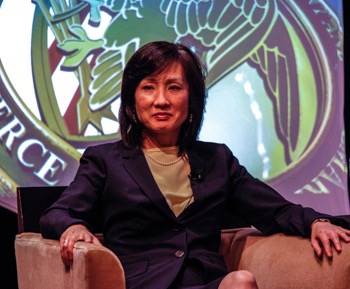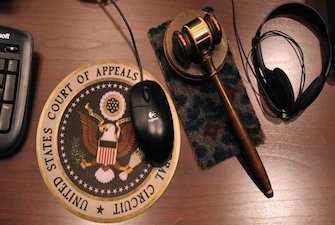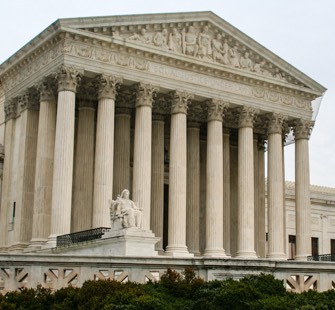USPTO undertakes review of PTAB, IPR proceedings
 The United States Patent and Trademark Office (USPTO) recently announced that, at the direction of USPTO Director Michelle Lee (shown left), the Office is launching an initiative “to further shape and improve Patent Trial and Appeal Board (PTAB) trial proceedings, particularly inter partes review proceedings.” According to the USPTO, the purpose of the initiative is to ensure that post grant proceedings are both effective and as fair as possible.
The United States Patent and Trademark Office (USPTO) recently announced that, at the direction of USPTO Director Michelle Lee (shown left), the Office is launching an initiative “to further shape and improve Patent Trial and Appeal Board (PTAB) trial proceedings, particularly inter partes review proceedings.” According to the USPTO, the purpose of the initiative is to ensure that post grant proceedings are both effective and as fair as possible.
The timing of the announcement is curious given that Michelle Lee’s days may be numbered as Director of the Office. As first reported on IPWatchdog.com, Commerce Secretary Wilbur Ross has interviewed at least three candidates for the position of Under Secretary of Commerce for Intellectual Property and Director of the United States Patent and Trademark Office: Phil Johnson, former Vice-President for Intellectual Property Strategy & Policy for Johnson & Johnson; Randall Rader, former Chief Judge of the United States Court of Appeals for the Federal Circuit; and an unidentified patent attorney characterized by one source as a “dark horse” candidate.
PTAB may invalidate claims federal courts confirmed valid
 The United States Court of Appeals for the Federal Circuit recently issued an opinion in Novartis AG v. Noven Pharmaceuticals, Inc., which affirmed the Patent Trial and Appeal Board (PTAB) invalidation of claims in related inter partes review (IPR) proceedings. The IPRs related to U.S. Patent No. 6,316,023 and U.S. Patent No. 6,335,031.
The United States Court of Appeals for the Federal Circuit recently issued an opinion in Novartis AG v. Noven Pharmaceuticals, Inc., which affirmed the Patent Trial and Appeal Board (PTAB) invalidation of claims in related inter partes review (IPR) proceedings. The IPRs related to U.S. Patent No. 6,316,023 and U.S. Patent No. 6,335,031.
Patent owners losing claims and the Federal Circuit rubber stamping the PTAB isn’t news, sadly. What makes this case different, however, is that these very same patents were previously litigated and the claims were found to be nonobvious in federal district court.
Novartis argued to the Federal Circuit that the arguments presented to the PTAB by Noven, as well as the prior art submitted to support those arguments, were the same as considered during litigation in federal court. The Federal Circuit disagreed, finding that the record in federal court was not identical to the record at the PTAB. But the Federal Circuit went further, saying that even if the records were identical, Novartis’ argument would have to fail.
05.22.17 | Federal Circuit Cases, Patent Issues | Gene Quinn
PTAB ineffective at eliminating low-quality patents
Those who engage in patent assertion activity are not per se bad actors, or patent trolls, simply because they choose to exercise the exclusive rights granted by the federal government. In fact, the FTC recently acknowledged the term “patent troll” isn’t helpful. “In the Commission’s view, a label like ‘patent troll’ is unhelpful because it invites pre-judgment about the societal impact of patent assertion activity without an understanding of the underlying business model that fuels such activity,” the report reads.
Of course, it is true that the number of patent infringement lawsuits are up significantly compared to the 1980s. It is also true, however, that the increase in patent infringement lawsuits that came after passage of the America Invents Act (AIA) was deemed desirable by Congress. Indeed, it seems that Congress specifically envisioned more patent infringement cases (i.e., a higher volume) because they made the conscious choice to make it difficult (if not impossible) for patent owners to sue large numbers of infringers in the same lawsuit. Thus, the spike in cases that came after 2011 was an intentional feature of the AIA. Even that being the case, quarter after quarter we see patent litigation declining. See here, here and here, for example.
04.29.17 | America Invents Act, Patent Issues, Patent Litigation, Patent Trolls | Gene Quinn
Laches no defense to patent infringement during statute of limitations
 The United States Supreme Court recently issued its decision in SCA Hygiene Products Aktiebolag et al. v. First Quality Baby Products, LLC, et al. The issue before the Supreme Court was whether the defense of laches remained a viable defense to patent infringement actions brought during the exceptionally long six-year statute of limitations. The Supreme Court ruled that the defense of laches is inappropriate for claims brought within the statute of limitations, hardly a shocking ruling given that the Court reached the same ruling only several years ago with respect to laches as a defense in copyright infringement claims. See Petrella v. Metro-Goldwyn-Mayer, Inc., 572 U.S. ___ (2014).
The United States Supreme Court recently issued its decision in SCA Hygiene Products Aktiebolag et al. v. First Quality Baby Products, LLC, et al. The issue before the Supreme Court was whether the defense of laches remained a viable defense to patent infringement actions brought during the exceptionally long six-year statute of limitations. The Supreme Court ruled that the defense of laches is inappropriate for claims brought within the statute of limitations, hardly a shocking ruling given that the Court reached the same ruling only several years ago with respect to laches as a defense in copyright infringement claims. See Petrella v. Metro-Goldwyn-Mayer, Inc., 572 U.S. ___ (2014).
Unlike most patent decisions, the decision in SCA Hygiene Products was not unanimous. The majority opinion was delivered by Justice Alito, who was joined by the Chief Justice, as well as Justices Kennedy, Thomas, Ginsburg, Sotomayor, and Kagan. A dissent was filed by Justice Breyer, who would have affirmed the Federal Circuit ruling finding that 35 U.S.C. 282 codified a laches defense without using the term “laches.” It was Justice Breyer’s belief that the codified defense of unenforceability allowed for a laches defense to patent infringement actions, explaining that in very old cases interpreting the common law, laches was at times equated to unenforceability.
04.26.17 | Patent Issues, Patent Litigation, posts, Supreme Court Cases | Gene Quinn
On the Record with Russ Slifer
 Russ Slifer is the former Deputy Under Secretary of Commerce for Intellectual Property and Deputy Director of the United States Patent and Trademark Office (USPTO). Slifer resigned from this position he held for nearly two years on Friday, January 20, 2017.
Russ Slifer is the former Deputy Under Secretary of Commerce for Intellectual Property and Deputy Director of the United States Patent and Trademark Office (USPTO). Slifer resigned from this position he held for nearly two years on Friday, January 20, 2017.
During his time at the Patent Office, I tried to get an interview with Slifer on a variety of occasions, but those efforts all went for naught. Upon his resignation, Silfer agreed to an interview, which took place via telephone on Monday, March 20, 2017. The entire 3-part interview transcript is available on IPWatchdog.com. What follows are the highlights.
Slifer on the mechnics and timing of resigning from a political appointment:
SLIFER: Each department in the Executive branch, let’s say the Department of Commerce has a White House liaison that interfaces between the political appointees that are under the Department of Commerce and the White House regarding employment issues. So when we’re approaching the end of an administration, they’re working with us on the transition out. They provided us a letter that came from the White House, let’s see, I think it was probably in December, maybe early December, that outlined that the President wanted all of our letters of resignation on file by a certain date and our intended date of departure. We were instructed that our resignation would be no later than noon on January 20th. So we basically got an instruction from the White House that they wanted everybody’s resignation letter and what it would say in it.
04.25.17 | Inter Partes Review, Patent Issues, posts, USPTO | Gene Quinn





No Comments
05.23.17 | Inter Partes Review, Patent Issues, USPTO | Gene Quinn